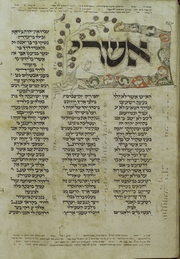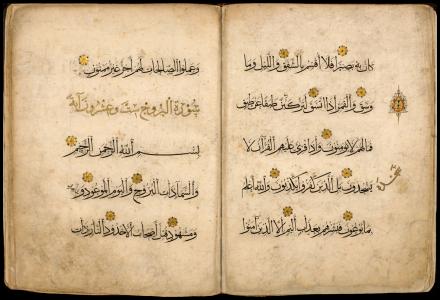by Elissa Lerner
If you walk into the Gottesman Exhibition Hall at the New York Public Library right now, you can’t help but notice a wave of warm, damp air. In an exhibition that could easily have been expanded to fill the more heavily trafficked halls of museums like the Met, the New York Public Library has dug through its archives and pulled out an awe-inspiring collection of the most awe-inspired books in the world: rare copies of the holy texts of Judaism, Christianity and Islam. But a larger space for Three Faiths (free, now through February 27th) would have ruined the atmosphere; book reading, or book gazing in this context, is a cozy and leisurely activity, far from the crowds of Museum Mile.
Highlights from the exhibit (and there are many) include a Quran from Istanbul dating to 1103 with clearly identifiable human figures and faces, which became increasingly rare in Quranic art. Another gem is a Samaritan Bible from 1232 written in Paleo-Hebrew script, which some trace to descendants of the northern kingdom of Israel. (Judah, the southern kingdom, adopted Aramaic script, creating a visual and literary break with the other tribes.) Yet perhaps the most remarkable text is not text at all, but the art accompanying a small copy of the Gospels from Ge’ez, Ethiopia, dating to the 15th century. The book is open to a portrait of a Madonna and Child that initially resembles a Byzantine style, until you can’t help but notice the bright orange, yellow and green fabrics (European holy colors are red and blue), and the brown skin of the holy family.
Other linguistic treats which seem inconceivable today – such as Alcorani, an Arabic-Latin Quran from 1655, or a Hebrew-Marathi siddur from the Bene Israel of India – nest themselves among the other treasures without unnecessary fanfare. Every book in the exhibit has a fascinating story to tell, and you get the feeling it’s probably not the one lying within its pages.

"The Tanakh (The Xanten Bible)" Hebrew Bible, vol. 1. Joseph ben Kalonymus, scribe. Xanten, Lower Rhineland, 5054 AM (1294 CE). The NYPL, Spencer Collection.
Conveniently enough, this was the gist of Karen Armstrong’s message during her January 11 lecture at the NYPL on “The 12 Steps to a Compassionate Life” (also the title of her latest book, the product of a TED grant). Compassion, she argues, has so fallen out of our lexicon that we most associate it with pity. Rather, she says, compassion is about creating space within ourselves for the Other, to appreciate our own stories and pain, but to understand that everyone around us has their own stories and suffering, too. It’s a matter of putting our egos aside, and recognizing “the profundity of human ignorance.”
Armstrong, the former Roman Catholic nun cum religion historian and biographer of God, is not shy about her intellectual, compassionate heroes. Socrates, the Buddha, Jesus, Shakespeare, Confucius, and Sufi mystics peppered her talk, and while she acknowledged that all religions are not the same, she held that the kernel of compassion embodied by the Golden Rule can be found in all major world religions. In one of her charming anecdotes (and Armstrong, with her silver blond hair and musical British voice was nothing if not charming), she mentioned a taxi driver who complained that religion is the cause of all war. “That’s ridiculous,” Armstrong scoffed, “the cause of war is usually ambition, greed, envy, and so on.” Her goal is to “restore the Golden Rule and the idea of compassion to the heart of religious life.”

Gospels (Harkness Gospels), in Latin. Landévennec, Brittany, before 917. New York Public Libary, Manuscripts and Archives Division. ("Explicit of prologue and incipit of the Gospel of Mark. Unusual symbol for Mark: a horse.")
A laudable goal, certainly, but Armstrong’s recipe for compassion tasted somewhat bland. She is not the first to call for setting aside our egoistic impulses, nor is she the first to figure out what to do with them when they return. Where is the prescription for how to make use of our egos that can also satisfy compassionate ends? We need mixed-use blueprints when building our selves, ways to find compassionate work – and it is undoubtedly work – gratifying and beneficial not just for the Other but for ourselves, too. The idea that she “made a place” in her mind to enter into 7th c. Arabia in order to empathize (her word) with the Quran or Muhammad or its adherents is very nice, but isn’t it also a bit presumptuous to think that her imagination could temporarily stand in for belief? Isn’t there something radically different between a mental exercise and a mental state? Suffice to say, heavy philosophy was not on the menu.
Consequently, Armstrong’s strongest moments were when she spoke freely about her own mental state – that of an academic. The audience of over 250 was utterly enraptured as she dove into the etymologies and evolutions of words like “mystery,” “compassion,” and “belief.” You got the feeling she could make biblical history come alive to children today while using an iPad to turn the illuminated manuscripts of the NYPL exhibit into the best bedtime story you never heard. At the end, an audience member asked her about the state of her own belief these days. Tellingly, she replied, “I have moments of awe and wonder while studying at my desk. Would I call it God? God knows.”
Elissa Lerner is a freelance journalist and playwright. She is an M.A. candidate and the 2009 Goren Fellow in Religious Studies and Journalism at the Arthur L. Carter Journalism Institute at NYU and a contributor to The Revealer.

